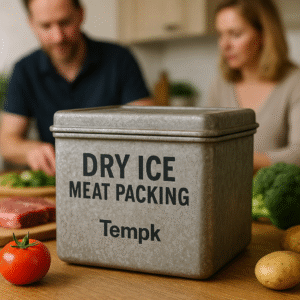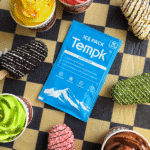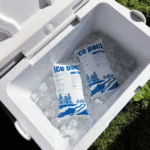Fleischverpackung von Trockeneis: Schiffsgefrorenes Fleisch sicher in 2025
Rindfleisch muss zwei Tage lang bei –18 °C aufbewahrt werden? Fleischverpackung mit Trockeneis ermöglicht Ihnen den Transport von Premium-Teilstücken im ganzen Land ohne Kühlwagen. Innerhalb der ersten 24 Stunden, 3-8 % des Eises sublimiert, Daher kommt es auf eine präzise Auslastung an. Heute lernen Sie die aktuellen Regeln kennen, Mathe, und Materialien, die über den Erfolg oder Misserfolg einer Lieferung entscheiden – und wie man es jedes Mal richtig macht.

Dieser Leitfaden antwortet
-
Wie viel Trockeneis reicht für eine 48-Stunden-Reise?? (Langstufe: „Trockeneis pro Pfund Fleisch“)
-
Welche 2025 Vorschriften könnten Ihren Versand verzögern? (Langstufe: „IATA-Trockeneisregeln 2025“)
-
Welche Verpackung hält Feuchtigkeit und CO₂ von Ihrem Produkt fern??
-
So senken Sie die Kosten mit einem Trockeneisrechner und Datenloggern
Ist die Verpackung von Trockeneisfleisch immer noch der Goldstandard für den Tiefkühlversand? 2025?
Ja – denn Trockeneis bleibt ohne Strom bei –78 °C, Dadurch erhalten Sie einen größeren Wärmepuffer als Gelpacks oder Phasenwechselpaneele. Carrier akzeptieren es immer noch weltweit, und die Sublimation hinterlässt kein Schmelzwasser, das Bakterienwachstum auslösen könnte. In den Leitlinien des USDA wird Trockeneis weiterhin als primäre Kältequelle für verschicktes Fleisch aufgeführt.
Warum es dir wichtig ist: auch wenn es auf einer Etappe der Reise zu Verzögerungen kommt, Ein Block Trockeneis verschafft zusätzliche Stunden, bevor die Produkttemperatur über –18 °C steigt. Wenn Sie einen Datenlogger hinzufügen, erhalten Sie einen Konformitätsnachweis.
Vergleich der Kühloptionen für den Versand von gefrorenem Fleisch
| Kühlmedium | Halten Sie den Temperaturbereich | Avg. Dauer (24 H) | Für Sie |
|---|---|---|---|
| Trockeneis (-78 ° C) | –50°C bis –18°C | 48–72H | Längster Schutz; erfordert Gefahrengutetiketten |
| Gelpackungen (–20 ° C.) | –20°C bis –5°C | 24–48H | Gut für gemischte Beladungen; höheres Schmelzrisiko |
| PCM-Panels (0 ° C / –15 ° C.) | –15°C bis 4°C | 24 H | Umweltfreundlich; begrenzt für Tiefkühlware |
Practical Tips
-
Luftspalt: Füllen Sie Hohlräume mit Liner, um die Sublimation zu verlangsamen und ein Verbrennen des Fleisches zu verhindern.
-
Block vs. Pellet: Wählen Sie 5-Pfund-Blöcke für ≥48 Stunden; Pellets wirken über Nacht.
-
Schichtung: Eis oben und unten, um Konvektion im Inneren der Box zu berücksichtigen.
Real Case: Ein Verarbeiter aus dem Mittleren Westen verschiffte im Juli 30 Pfund Steaks mit 15 Pfund Trockeneis und einem 2-Zoll-EPS-Kühler nach Florida; Die Ankunftstemperatur betrug nach 60 Stunden –23°C, Bestehen des USDA-Audits.
Wie viel Trockeneis benötigen Sie für die Fleischverpackung??
Faustregel: Verwenden Sie alle 24 Stunden 5–10 Pfund Trockeneis pro Kubikfuß gefrorenem Fleisch. Trockeneis sublimiert je nach Isolationsqualität und Umgebungstemperatur 3–8 % seiner Masse pro Tag.
-
Berechnen Sie die Produktbelastung: Fleischgewicht × 0,3 Pfund Eis pro Pfund Fleisch für 48 Stunden.
-
Isolationsfaktor hinzufügen: 20 % zusätzliches Eis für einwandige Wellpappe, 10 % für 2-Zoll-EPS.
-
Transitpuffer einbeziehen: +10 % für Servicelücken am Wochenende/Feiertag.
Welche Vorschriften regeln die Verpackung von Trockeneisfleisch? 2025?
Luftfracht: Die IATA-Gefahrgutvorschriften66 erfordern eine UN1845-Kennzeichnung, Nettogewichtsetikett, und eine ausgefüllte Trockeneis-Checkliste; Das Nettogewicht pro Paket ist je nach Flugzeugtyp begrenzt.
Grundstück/Parzelle: USPS und Kurierdienste befolgen die PHMSA-Regeln – deklarieren Sie „Trockeneis“., Und 1845, Klasse 9“ und entlüften Sie die Box. Einige Spediteure begrenzen Trockeneis im Inland auf 5,5 Pfund, sofern nicht anders angegeben.
Lebensmittelsicherheit: Das USDA schreibt vor, dass die Fleischkerntemperaturen bei ≤4,4 °C bleiben dürfen (40 ° F) für frisch, ≤–18°C (0 ° F) für gefroren; Schnelle Kühlung mittels Trockeneis oder flüssigem CO₂ wird akzeptiert.
2025 Trends in der Trockeneisfleischlogistik
Neue Pelletierer gewinnen CO₂ aus Brauereiabgasen zurück, Kostensenkung um bis zu 18 %. KI-Routenplanungsplattformen integrieren Echtzeit-Sublimationsmodelle, um übermäßiges Packen zu reduzieren, während der 66‑ed DGR digitale Checklisten einführt, Verkürzung der Ausschreibungszeit um 12 %.
Trend-Schnappschuss
-
Rückgewonnene CO₂-Produktion: Reduziert den ökologischen Fußabdruck und den Stückpreis.
-
Intelligente isolierte Liner: Mit Aerogel angereichertes EPS halbiert den Wärmegewinn.
-
Digitale DGR-Tools: Die automatische Etikettenerstellung reduziert manuelle Fehler.
Market insight: Es wird erwartet, dass der weltweite E-Commerce für gefrorenes Fleisch bis zum Jahr 14 Milliarden US-Dollar erreichen wird 2027, Angetrieben wird dies durch landwirtschaftliche Betriebe, die direkt an den Verbraucher liefern und Trockeneis-Sets bündeln.
FAQ
Wie entsorge ich unbenutztes Trockeneis sicher??
Platzieren Sie übriggebliebenes Eis an einem gut belüfteten Ort bei Raumtemperatur; es wird erhaben sein. Von Kindern und Haustieren fernhalten.
Kann ich zum Kühlen Trockeneis verwenden? (nicht gefroren) Fleisch?
Ja, aber trennen Sie es mit Pappe, um ein Einfrieren der Oberfläche zu vermeiden; Erwägen Sie stattdessen Gel-Packs für 0–4 °C-Ziele.
Ist Trockeneis in internationalen Paketen erlaubt??
Die meisten Länder akzeptieren es gemäß UN1845, Überprüfen Sie jedoch die örtlichen CO₂-Grenzwerte und legen Sie Zollpapiere gemäß IATA DGR vor.
Key Takeaways
-
Trockeneis bietet den tiefsten Gefriergrad und die längste Haltezeit für den Fleischversand.
-
Berechnen Sie 5–10 Pfund pro Kubikfuß und kennzeichnen Sie ihn gemäß UN1845, um die Anforderungen zu erfüllen 2025 Regeln.
-
Verwenden Sie 2-Zoll-EPS- oder Aerogel-Liner, um die Sublimations- und Frachtkosten zu senken.
-
Fügen Sie einen Datenlogger und einen interaktiven Rechner hinzu, um die Compliance nachzuweisen und das Vertrauen der Kunden zu stärken.
Nächste Schritte
-
Führen Sie unseren Trockeneis-Rechner aus um die Größe Ihrer nächsten Sendung festzulegen.
-
Laden Sie die herunter 2025 DGR-Zusammenfassung konform bleiben.
-
Buchen Sie ein kostenloses Verpackungsaudit mit unseren Kühlketteningenieuren.
Über Tempk
Wir sind ein Anbieter von Kühlkettenlösungen, der sich auf Hochleistungs-EPS- und Aerogel-Versender spezialisiert hat. Unser hauseigenes Labor validiert jede Box gemäß ISTA7E-Profilen, und unser Trockeneisprogramm mit wiedergewonnenem CO₂ reduziert die Emissionen um 15 %. Lassen Sie uns Ihr Fleisch kälter halten, länger.
Bereit für einen intelligenteren Versand? Kontaktieren Sie uns noch heute für ein individuelles Angebot.























